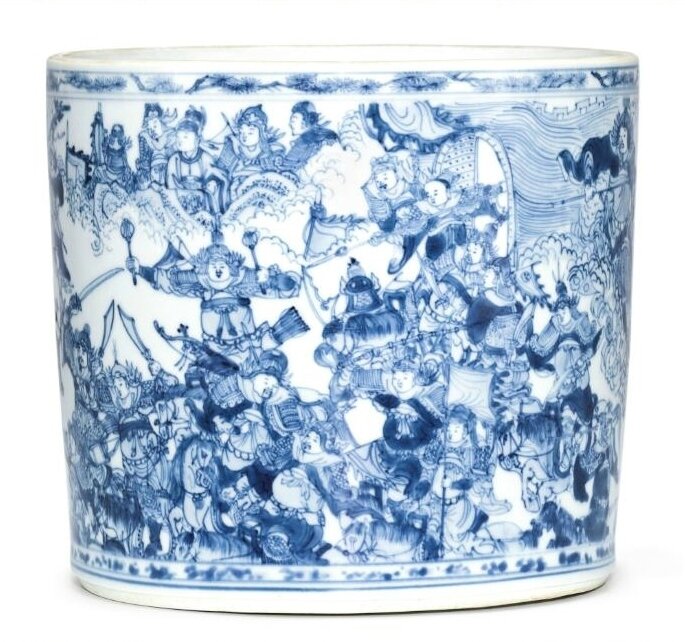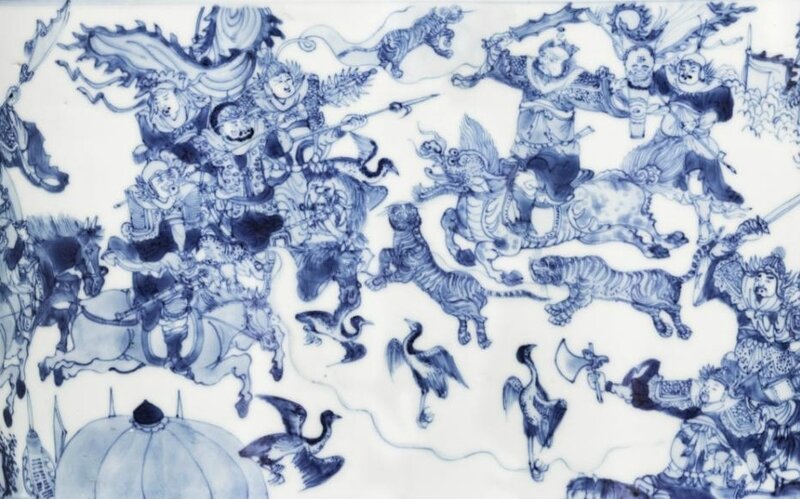A superb blue and white brushpot, Transitional period
Lot 317. A superb blue and white brushpot, Transitional period. d. 18.6 cm, 7 3/8 in. Estimate 100,000 — 150,000 HKD. Lot sold 1,375,000 HKD (147,783 EUR). Courtesy Sotheby's.
of cylindrical form, the exterior delicately painted in fine details with a scene from the story Fengshen yanyi, depicting Wen Zhong riding on a mo qilin and leading his equestrian soldiers battling against another group of equestrian warriors, all amongst ferocious leaping tigers and soaring cranes before a city gate, the rim encircled by a band of pine branches and the foot skirted with dabs of cobalt-blue splashes.
Provenance: Collection of T.Y. Chao (1912-1999), and thence by descent in the family.
Note: This brushpot is striking for its dynamic and lively design that extends throughout the surface of the vessel. Rendered in fine almost pencilled lines, it depicts a scene from the story Fengshen yanyi/Investiture of the Gods, a major vernacular work written in the 16th century, narrating the military campaigns of the last evil king of the Shang dynasty against the sagacious founders of the Zhou dynasty. The central figure depicts the grand master to the King Zhou of Shang, Wen Zhong, mounted on the mythical animal mo qilin, the strongest among its kind. Although outnumbered by the opposing Zhou entourage led by a variety of deities, magicians and mounted cavalries bearing banners, he demonstrates his military prowess through his spiritual power to summon animals to fight against the enemy. Wen Zhong ultimately became the Daoist God of Thunder, Puhua tianzun, for his unprecedented loyalty and dedication to his people.
Brushpots of this type were often adorned with scenes from popular literature, such as one in the Palace Museum, Beijing, illustrated in Compendium of Collection in the Palace Museum. Ceramics, vol. 21, Shunzhi (1644 – 1661) and Kangxi (1662 – 1722) Period of Qing Dynasty (1), 2013, pl. 181; another sold in these rooms, 28th November 1979, lot 183; and a third sold at Christie's New York, 22nd March 2012, lot 1279.
An unusual large blue and white brush pot, Kangxi period (1662-1722). 6 7/8 in. (17.5 cm.) high. Sold for 108,100 USD at Christie's New York, 22nd March 2012, lot 1279. © Christies Images Ltd 2012
The sides finely painted with an audience scene amidst pine trees between a Tibetan Lama, surrounded by his attendants and a group of Tibetan monks, and Chinese dignitaries accompanied by their attendants, the scene terminating in clouds on one side, all between decorative borders.
Note: This exceptionally well-painted brush pot is rare, not only for its large size, but for the choice of its decorative theme. Porcelain brush pots decorated in underglaze blue with scenes of figures in a landscape became very popular amongst the Chinese literati in the 17th century. Often the inspiration for the scenes was taken from woodblock-printed illustrated editions of plays and histories, or illustrations of famous poems. The current brush pot, however, is exceedingly rare in depicting a Tibetan Lama accompanied by monks apparently in an audience with a high Chinese official. The incense burning on the stand and the gesticulations of the official suggest that the meeting is not accidental and may be of considerable significance.
Tibetan, or Lamaist, Buddhism came to prominence in the Kangxi period under the auspices of the emperor himself. The Kangxi Emperor was only the second Manchu emperor to rule China after the Manchus 'crossed the Great Wall,' following the reign of his father, the Shunzhi Emperor. Since this dynasty was one in which China was ruled by foreigners, the Manchus, emperors had, on the one hand, to prove to their Chinese subjects that they held the Mandate of Heaven to rule; while, at the same time, dealing with China's frequently aggressive neighbors to the north and west. Most of the military challenges to the Manchus traditionally came from Inner Asia, with the Mongols being particularly troublesome. Much of the Manchus' success came from military supremacy, but, in the late 17th and 18th centuries, diplomacy was also employed to achieve the same ends. This was cemented by marriages between Manchus and the Mongol tribes - indeed the Kangxi Emperor's grandmother was a Mongol princess. The Manchus, like the Mongols, converted to Tibetan Buddhism. In 1642 the Mongol leader Gui Khan had made the Fifth Dalai Lama the secular as well as the religious ruler of Tibet. This power was expanded by the Fifth Dalai Lama and his influence became such that he could act as peace-maker between Mongol tribes and could even order the movements of Mongol armies outside Tibet. The Qing court's relationships with the Mongols and the Tibetan Dalai Lama were therefore intertwined.
Although it is often said that the Qing dynasty emperors patronized Tibetan Buddhism only for political reasons, this does not seem to have been the case with the Kangxi emperor. He was largely brought up by his grandmother, to whom he was devoted. As noted above, she was a Mongol princess, named Bumbutai, and an adherent of Tibetan Buddhism. It is probably due to her that the Kangxi emperor was the first Qing emperor to demonstrate a personal religious commitment to Lamaism. Bumbutai, who claimed descent from Genghis Khan, wielded considerable influence during the minority of her own son, the Shunzhi Emperor, and when the Kangxi emperor came to the throne, also as a minor, she received the title Grand Empress Dowager. Bumbutai guided the Kangxi Emperor, especially after his mother died in 1663, and retained a strong influence over him.
Such was the Kangxi Emperor's devotion to Lamaist Buddhism that during his reign a Sutra Recitation Office was set up and housed within the palace in the Zhongzhengdian (Hall of Central Uprightness). This office was the first to be solely devoted to Tibetan Buddhist affairs, and was part of the inner court's Department of Ceremonial, supervised by imperial princes. The Zhongzhengdian was to become the center of Tibetan Buddhist activities at court, and not only conducted the recitation of sutras but also supervised the casting of Buddhist images and religious ritual objects. Like succeeding Qing emperors, the Kangxi Emperor portrayed himself as a bodhisattva-ruler - a reincarnation of Manjusri (the Bodhisattva of Wisdom) - and it is therefore not so surprising to find a depiction of a meeting between a high Lama and a Chinese high official on a brush pot made for the literati during his reign.
Sotheby's. Chinese Art including Selected Works of Art from the T.Y. Chao Family Collection, Hong Kong, 30 Nov 2017, 02:00 PM

/https%3A%2F%2Fprofilepics.canalblog.com%2Fprofilepics%2F1%2F0%2F100183.jpg)
/https%3A%2F%2Fstorage.canalblog.com%2F03%2F02%2F119589%2F96711876_o.jpg)
/https%3A%2F%2Fstorage.canalblog.com%2F11%2F31%2F119589%2F94773502_o.jpg)
/https%3A%2F%2Fstorage.canalblog.com%2F20%2F83%2F119589%2F94772815_o.jpg)
/https%3A%2F%2Fstorage.canalblog.com%2F26%2F72%2F119589%2F75604929_o.jpg)
/https%3A%2F%2Fstorage.canalblog.com%2F59%2F60%2F119589%2F26458628_o.jpg)






/image%2F1371349%2F20240416%2Fob_2a8420_437713933-1652609748842371-16764302136.jpg)
/image%2F1371349%2F20240414%2Fob_83ee65_2024-nyr-22642-0954-000-a-blue-and-whi.jpg)
/image%2F1371349%2F20240414%2Fob_15808c_2024-nyr-22642-0953-000-a-blue-and-whi.jpg)
/image%2F1371349%2F20240414%2Fob_e54295_2024-nyr-22642-0952-000-a-rare-blue-an.jpg)